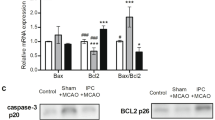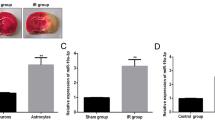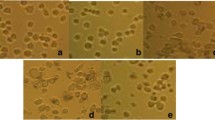Abstract
We explored the response of a panel of selected microRNAs (miRNAs) in neuroprotection produced by ischemic preconditioning. Hippocampal neuronal cultures were exposed to a 30-min oxygen–glucose deprivation (OGD). In our hands, this duration of OGD does not result in neuronal loss in vitro but significantly reduces neuronal death from a subsequent ‘lethal’ OGD insult. RT-qPCR was used to determine the expression of 16 miRNAs of interest at 1 and 24-h post-OGD. One miRNA (miR-98) was significantly decreased at 1-h post-OGD. Ten miRNAs (miR-9, miR-21, miR-29b, miR-30e, miR-101a, miR-101b, miR-124a, miR-132, miR-153, miR-204) were increased significantly at 24-h post-OGD. No miRNAs were decreased at 24-h. The increases observed in the 24-h group suggested that these miRNAs might play a role in preconditioning-induced neuroprotection. We selected the widely studied miR-132, a brain enriched, CREB regulated miRNA, to explore its role in simulated ischemic insults. We found that hippocampal neurons transduced with lentiviral vectors expressing miR-132 were protected from OGD and NMDA treatment, but not hydrogen peroxide. These findings add to the growing literature that targeting neuroprotective pathways controlled by miRNAs may represent a therapeutic strategy for the treatment of ischemic brain injury.



Similar content being viewed by others
References
Ballestar E, Wolffe AP (2001) Methyl-CpG-binding proteins. Targeting specific gene repression. Eur J Biochem 268:1–6
Berezikov E, Thuemmler F, van Laake LW, et al. (2006) Diversity of microRNAs in human and chimpanzee brain. Nat Genet 38:1375–1377
Bramham CR, Wells DG (2007) Dendritic mRNA: transport, translation and function. Nat Rev Neurosci 8:776–789
Bushati N, Cohen SM (2007) microRNA functions. Annu Rev Cell Dev Biol 23:175–205
Chahrour M, Jung SY, Shaw C, et al. (2008) MeCP2, a key contributor to neurological disease, activates and represses transcription. Science 320:1224–1229
Chen CS, Alonso JL, Ostuni E, et al. (2003) Cell shape provides global control of focal adhesion assembly. Biochem Biophys Res Commun 307:355–361
Dharap A, Bowen K, Place R, et al (2009) Transient focal ischemia induces extensive temporal changes in rat cerebral MicroRNAome. J Cereb Blood Flow Metab 29(4):675–687
Edbauer D, Neilson JR, Foster KA, et al. (2010) Regulation of synaptic structure and function by FMRP-associated microRNAs miR-125b and miR-132. Neuron 65:373–384
Glover CPJ, Heywood DJ, Bienemann AS, et al. (2004) Adenoviral expression of CREB protects neurons from apoptotic and excitotoxic stress. Neuroreport 15:1171–1175
Gogas KR (2006) Glutamate-based therapeutic approaches: NR2B receptor antagonists. Curr Opin Pharmacol 6:68–74
Hong S, Lee J, Seo H-H, et al. (2015) Na(+)-Ca(2+) exchanger targeting miR-132 prevents apoptosis of cardiomyocytes under hypoxic condition by suppressing Ca(2+) overload. Biochem Biophys Res Commun 460:931–937
Hwang J-Y, Kaneko N, Noh K-M, et al. (2014) The gene silencing transcription factor REST represses miR-132 expression in hippocampal neurons destined to die. J Mol Biol 426:3454–3466
Jeyaseelan K, Lim KY, Armugam A (2008) MicroRNA expression in the blood and brain of rats subjected to transient focal ischemia by middle cerebral artery occlusion. Stroke 39:959–966
Jimenez-Mateos EM, Bray I, Sanz-Rodriguez A, et al. (2011) miRNA expression profile after status epilepticus and hippocampal neuroprotection by targeting miR-132. Am J Pathol 179:2519–2532
Jung BP, Zhang G, Ho W, et al. (2002) Transient forebrain ischemia alters the mRNA expression of methyl DNA-binding factors in the adult rat hippocampus. Neuroscience 115:515–524
Kelly S, Zhang ZJ, Zhao H, et al. (2002) Gene transfer of HSP72 protects cornu ammonis 1 region of the hippocampus neurons from global ischemia: influence of Bcl-2. Ann Neurol 52:160–167
Kelly S, Bliss TM, Shah AK, et al. (2004a) Transplanted human fetal neural stem cells survive, migrate, and differentiate in ischemic rat cerebral cortex. Proc Natl Acad Sci U S A 101:11839–11844
Kelly S, Zhao H, Hua Sun G, et al. (2004b) Glycogen synthase kinase 3beta inhibitor Chir025 reduces neuronal death resulting from oxygen-glucose deprivation, glutamate excitotoxicity, and cerebral ischemia. Exp Neurol 188:378–386
Kim J, Inoue K, Ishii J, et al. (2007) A MicroRNA feedback circuit in midbrain dopamine neurons. Science 317:1220–1224
Kim VN, Han J, Siomi MC (2009) Biogenesis of small RNAs in animals. Nat Rev Mol Cell Biol 10:126–139
Kim J, Yoon H, Horie T, et al. (2015) MicroRNA-33 regulates ApoE lipidation and amyloid-β metabolism in the brain. J Neurosci 35:14717–14726
Klein ME, Klein ME, Lioy DT, et al. (2007) Homeostatic regulation of MeCP2 expression by a CREB-induced microRNA. Nat Neurosci 10:1513–1514
Kosik KS (2006) The neuronal microRNA system. Nat Rev Neurosci 7:911–920
Lee YB, Bantounas I, Lee DY, et al. (2008) Twist-1 regulates the miR-199a/214 cluster during development. Nucleic Acids Res 37(1):123–8. doi:10.1093/nar/gkn920
Lin W-Y, Chang Y-C, Lee H-T, Huang C-C (2009) CREB activation in the rapid, intermediate, and delayed ischemic preconditioning against hypoxic-ischemia in neonatal rat. J Neurochem 108:847–859
Liu D, Tian Y, Ander B et al (2010) Brain and blood microRNA expression profiling of ischemic stroke, intracerebral hemorrhage, and kainate seizures. J Cereb Blood Flow Metab 30(1):92–101
Lusardi TA, Farr CD, Faulkner CL et al (2010) Ischemic preconditioning regulates expression of microRNAs and a predicted target, MeCP2, in mouse cortex. J Cereb Blood Flow Metab 30(4):744–756
Magill ST, Cambronne XA, Luikart BW, et al. (2010) microRNA-132 regulates dendritic growth and arborization of newborn neurons in the adult hippocampus. Proc Natl Acad Sci U S A 107:20382–20387
Meller R, Minami M, Cameron JA, et al. (2005) CREB-mediated Bcl-2 protein expression after ischemic preconditioning. J Cereb Blood Flow Metab 25:234–246
Miska EA, Alvarez-Saavedra E, Townsend M, et al. (2004) Microarray analysis of microRNA expression in the developing mammalian brain. Genome Biol 5(9):R68
Mushtaq G, Greig NH, Anwar F, et al (2015) miRNAs as circulating biomarkers for Alzheimer’s disease and Parkinson’s disease. [Epub ahead of print]
Nakazawa T, Watabe AM, Tezuka T, et al. (2003) p250GAP, a novel brain-enriched GTPase-activating protein for Rho family GTPases, is involved in the N-methyl-d-aspartate receptor signaling. Mol Biol Cell 14:2921–2934
Nakazawa T, Kuriu T, Tezuka T, et al. (2008) Regulation of dendritic spine morphology by an NMDA receptor-associated Rho GTPase-activating protein, p250GAP. J Neurochem 105:1384–1393
Nudelman A, Dirocco D, Lambert T, et al. (2009) Neuronal activity rapidly induces transcription of the CREB-regulated microRNA-132, in vivo. Hippocampus 20(4):492–498
Schäbitz WR, Schwab S, Spranger M, Hacke W (1997) Intraventricular brain-derived neurotrophic factor reduces infarct size after focal cerebral ischemia in rats. J Cereb Blood Flow Metab 17:500–506
Schäbitz WR, Sommer C, Zoder W, et al. (2000) Intravenous brain-derived neurotrophic factor reduces infarct size and counterregulates Bax and Bcl-2 expression after temporary focal cerebral ischemia. Stroke 31:2212–2217
Scott H, Howarth J, Lee Y-B, et al. (2012a) MiR-3120 is a mirror microRNA that targets heat shock cognate protein 70 and auxilin messenger RNAs and regulates clathrin vesicle uncoating. J Biochem 287:14726–14733. doi:10.1074/jbc.M111.326041
Scott HL, Tamagnini F, Narduzzo KE, et al. (2012b) MicroRNA-132 regulates recognition memory and synaptic plasticity in the perirhinal cortex. Eur J Neurosci 36:2941–2948
Semenova MM, Mäki-Hokkonen AMJ, Cao J, et al. (2007) Rho mediates calcium-dependent activation of p38alpha and subsequent excitotoxic cell death. Nat Neurosci 10:436–443
Shaked I, Meerson A, Wolf Y, et al. (2009) MicroRNA-132 potentiates cholinergic anti-inflammatory signaling by targeting acetylcholinesterase. Immunity 31:965–973
Smirnova L, Gräfe A, Seiler A, et al. (2005) Regulation of miRNA expression during neural cell specification. Eur J Neurosci 21:1469–1477
Smith PY, Delay C, Girard J et al (2011) MicroRNA-132 loss is associated with tau exon 10 inclusion in progressive supranuclear palsy. Hum Mol Genet 20(20):4016–4024
Strum JC, Johnson JH, Ward J, et al. (2009) MicroRNA 132 regulates nutritional stress-induced chemokine production through repression of SirT1. Mol Endocrinol 23:1876–1884
Vo N, Klein ME, Varlamova O, et al. (2005) A cAMP-response element binding protein-induced microRNA regulates neuronal morphogenesis. Proc Natl Acad Sci U S A 102:16426–16431
Wagner W, Horn P, Castoldi M, et al. (2008) Replicative senescence of mesenchymal stem cells: a continuous and organized process. PLoS one 3:e2213
Yanamoto H, Mizuta I, Nagata I, et al. (2000a) Infarct tolerance accompanied enhanced BDNF-like immunoreactivity in neuronal nuclei. Brain Res 877:331–344
Yanamoto H, Nagata I, Sakata M, et al. (2000b) Infarct tolerance induced by intra-cerebral infusion of recombinant brain-derived neurotrophic factor. Brain Res 859:240–248
Yin KJ, Deng Z, Huang HR et al (2010) miR-497 regulates neuronal death in mouse brain after transient focal cerebral ischemia. Neurobiol Dis 38(1):17–26
Zhao J, Pei D-S, Zhang Q-G, Zhang G-Y (2007) Down-regulation Cdc42 attenuates neuronal apoptosis through inhibiting MLK3/JNK3 cascade during ischemic reperfusion in rat hippocampus. Cell Signal 19:831–843
Acknowledgments
We would like to thank Dr. Youn-Bok Lee, Dr. Kate Whittington and Dr. Liang-Fong Wong for their help and advice during this project. This work was funded by University of Bristol funds to SK, grants to JBU from the Wellcome Trust and BBSRC. MPK held a BBSRC CASE studentship.
Author information
Authors and Affiliations
Corresponding authors
Rights and permissions
About this article
Cite this article
Keasey, M.P..., Scott, H.L., Bantounas, I. et al. MiR-132 Is Upregulated by Ischemic Preconditioning of Cultured Hippocampal Neurons and Protects them from Subsequent OGD Toxicity. J Mol Neurosci 59, 404–410 (2016). https://doi.org/10.1007/s12031-016-0740-9
Received:
Accepted:
Published:
Issue Date:
DOI: https://doi.org/10.1007/s12031-016-0740-9




